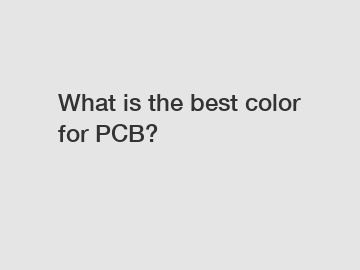What is the best color for PCB?
What is the best color for PCB? This question is commonly asked by designers and manufacturers in the field of electronics. While there isn't a definitive answer, Green is often regarded as the best color for PCBs due to various reasons.
The origin of the dominance of green in PCBs can be traced back to the early days of electronics manufacturing. In the 1960s, when the use of PCBs became common, the manufacturing process involved the use of epoxy resin solder masks. These masks were typically green in color, and as a result, green became associated with PCBs. Over time, this association has become deeply ingrained in the industry.
Aside from its historical roots, there are practical reasons why green continues to be the preferred color for PCBs. One important factor is the contrast it provides with the copper traces and electronic components. Green solder masks offer a high level of contrast, making it easier for technicians and engineers to visually inspect and troubleshoot the circuit boards. This contrast improves visibility, especially when dealing with intricate designs and densely populated boards.

Another reason for the popularity of green PCBs is its availability and cost-effectiveness. Since green has been the standard color for so long, PCB manufacturers have optimized their processes and have developed an extensive supply chain for green solder masks and PCB materials. As a result, green PCBs are readily available in the market and are typically more affordable compared to PCBs of other colors. This availability and cost-effectiveness make green an attractive choice, especially for projects with strict budget constraints.
The color of the PCB can also have implications in terms of functionality and performance. It is worth noting that the color of the solder mask affects heat dissipation. Darker colors, such as black or blue, have higher absorption of heat compared to lighter colors like green or white. This difference can impact the overall thermal performance of the PCB and may require additional measures to mitigate heat-related issues. Therefore, for applications where heat dissipation is a significant concern, choosing a lighter color like green can help optimize the board's thermal management.
In conclusion, while there isn't a definitive answer to the question of the best color for PCBs, green has emerged as the preferred choice due to historical association, contrast, availability, and cost-effectiveness. Additionally, the thermal implications of PCB color make green a practical choice for projects where heat dissipation is a consideration. However, it is essential to consider specific project requirements and consult with experts to determine the most suitable color for each application.
Are you interested in learning more about automotive pcb design , security product pcb board , industrial control pcb ? Contact us today to secure an expert consultation!


